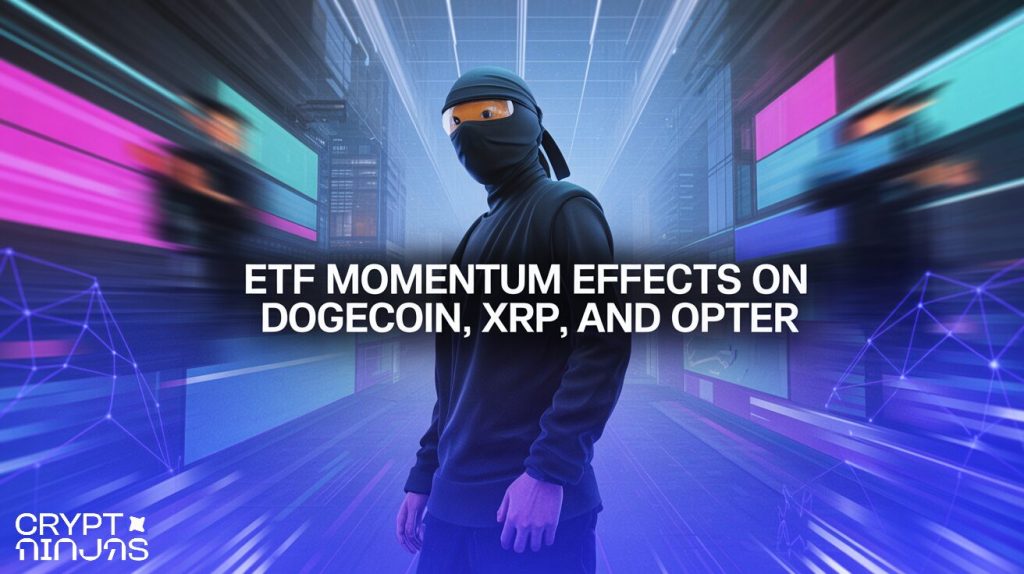ETF approvals always change the mood of the market. They pull in new money, calm nervous investors and make crypto feel a little more familiar to people who would never touch an exchange otherwise. Dogecoin, XRP and Opter sit in different corners of the ecosystem, but ETF activity affects each of them in its own way. Some gain from sentiment, some from legitimacy and some from the increase in trading behaviour that usually follows.
Dogecoin and The ETF Ripple Effect
Dogecoin has never pretended to be a serious asset, yet it somehow benefits every time the market grows up a little. When new traders arrive because an ETF makes crypto sound safe enough to try, they look for names they recognise. Dogecoin has brand recognition that most projects would kill for. It is familiar, it is simple and it moves fast when markets wake up.
ETF-driven inflows do not change Dogecoin’s fundamentals. What they change is the atmosphere around it. More newcomers. More casual buyers. More liquidity bouncing around the edges of the market. Dogecoin tends to pick up a noticeable share of that noise, and it has done so every cycle.
XRP and The Legitimacy Boost
XRP reacts to ETFs in a different way. For Dogecoin, the effect is cultural. For XRP, it is structural. The token has spent years fighting regulatory narratives, and every institutional step forward in crypto softens that backdrop. When ETFs attract banks, funds, or compliance-heavy organisations, the sentiment shift spills over.
XRP’s utility is not in question. It is fast, liquid and designed for cross-border settlement. Its barrier has always been optics. ETFs nudge regulators, analysts, and conservative investors toward the idea that crypto is an asset class with rules instead of a loosely connected hobby. Every step in that direction makes XRP look a little less controversial and a little more aligned with the traditional financial world it has tried to integrate with for years.
Where Opter Fits Into The Picture
Opter’s relationship with ETF activity is more direct. It is not a meme token or a settlement asset. It is a trading platform, and ETFs reliably increase trading behaviour. Newcomers enter the market, volatility rises and people start looking for platforms that feel fast, simple and transparent.
Opter offers exactly that. Traders connect a wallet, keep custody of their funds and open positions on crypto, stocks, indices, commodities and forex without identity checks. All settlements stay on-chain. No locked deposits. No approvals. Just trading.
The presale is live at $0.02 in Stage 1, and users can buy OPTER or earn it. For every $100k traded, users earn 800 OPTER tokens. It is a clean, activity-based mechanism that becomes even more attractive when ETF events increase market movement. Opter’s system adds a second layer. Traders level up and earn seasonal airdrops from real trading behaviour instead of random participation. In markets stirred by ETF headlines, that kind of progression loop feels natural, giving a breath of fresh air to what the markets demand.
Three Assets, Three Outcomes
Dogecoin gains new audiences whenever ETFs expand the market.
XRP benefits from institutional confidence and a cleaner regulatory tone.
Opter benefits directly from the increased trading volume and volatility ETFs tend to create.
Dogecoin, XRP and Opter respond to ETF activity in very different ways, but all three stand to gain something from a market that feels more open, more regulated, and more active.
Opter’s Stage 1 presale is open at $0.02, and early traders are already earning, so this is the time to join before the next stage moves.
Website: https://opter.io
Trade: https://app.opter.io
Discord: https://discord.com/invite/opterdex
$250K Giveaway: https://gleam.io/yTXSz/opter-250k-giveaway
Read more: Opter: A Look at the Emerging Perpetual Exchange Gaining Attention
Disclaimer
Please be advised that all information, including our ratings, advices and reviews, is for educational purposes only. Crypto investing carries high risks, and CryptoNinjas is not responsible for any losses incurred. Always do your own research and determine your risk tolerance level; it will help you make informed trading decisions.





